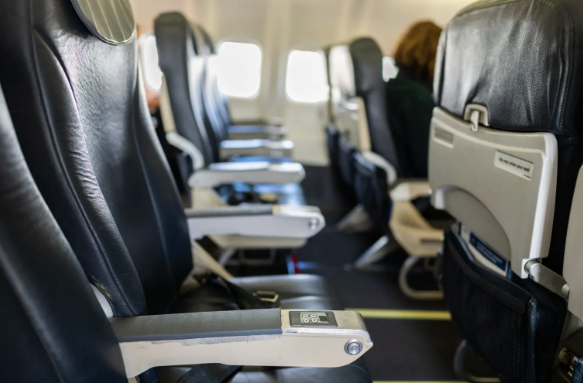Air travel can be stressful for anyone, but plus-sized passengers often face challenges that go far beyond the usual discomforts of tight seats or limited legroom. Imagine being on a long flight and discovering you can’t use the restroom because the aisle is too narrow or the lavatory is too cramped. This is a common and often overlooked reality for many individuals, including Bo Berry, whose candid account has brought much-needed attention to the barriers plus-sized travelers regularly encounter.

1. The Challenge of Airplane Design: Comfort vs. Capacity
Commercial aircraft are primarily designed with profitability in mind, leading airlines to prioritize seating capacity over passenger comfort. This often results in narrower aisles, tighter seating, and cramped lavatories. While such conditions can be uncomfortable for most travelers, they pose significant challenges for individuals who are plus-sized, elderly, or disabled.
Aircraft restrooms are particularly problematic. Built to occupy as little space as possible, they can be difficult to use even for average-sized passengers. For plus-sized travelers, simply reaching and fitting into these spaces can be nearly impossible. Bo Berry’s viral video, which captures her struggle to walk down the aisle of a narrow-body aircraft, has sparked widespread attention—pushing airlines to reconsider how inclusive their cabin designs truly are.
2. The Reality of Flying While Plus-Sized
From selecting the right seat to navigating physical limitations during a flight, plus-sized passengers often face a host of challenges. Even reaching their assigned seat can be difficult, as narrow aisles and tightly packed rows require awkward maneuvering. In her viral TikTok video, Bo Berry demonstrates how she has to turn sideways just to move down the aisle—a struggle that resonates with many.
Restroom access is another major concern. Bo, for example, limits her flights to no more than six hours because of the difficulty she experiences using standard airplane lavatories. This limitation not only restricts her travel options but also has a profound impact on her overall quality of life.
Beyond physical obstacles, emotional discomfort adds another layer of strain. Many plus-sized travelers report feeling anxious about fitting into their seats or fear judgmental stares from fellow passengers. The emotional toll can be just as burdensome as the physical challenges.
3. Community Voices and Advocacy
Bo Berry’s experience has struck a chord across social media, prompting thousands to share similar struggles. Her story has not only garnered widespread support but also ignited broader conversations about the need for greater inclusivity in air travel.
Commenters from a wide range of backgrounds—including individuals with disabilities and other mobility challenges—have expressed solidarity. Many others, regardless of size, have voiced frustrations over cramped conditions and limited accessibility. The common message running through these responses is clear: airlines must do more to accommodate the diverse needs of all passengers.
4. Toward More Inclusive Air Travel
A growing movement is calling for more inclusive air travel. Advocacy organizations like the National Council on Independent Living (NCIL) and All Wheels Up are leading efforts to push for systemic change, including wider aisles, accessible lavatories, and more flexible seating configurations.
Some airlines have started to take notice. Newer wide-body aircraft occasionally feature improved accessibility, but such advancements remain the exception rather than the norm. Advocates emphasize that meaningful progress will require industry-wide standards and regulatory action—not just isolated upgrades.
At its heart, this issue is about dignity. Every traveler, regardless of size or ability, deserves to feel safe, respected, and comfortable throughout their journey.
5. Tips for Plus-Sized Travellers: Flying with Confidence

Flying can be challenging, but with thoughtful planning and advocacy, plus-sized travelers can make the experience more manageable and comfortable. Here are some practical tips to help you prepare:
1. Choose the Right Airline and Aircraft
Research airlines known for roomier seating and more accommodating policies. When possible, opt for wide-body aircraft, which typically offer more space and improved accessibility.
2. Select Seats Strategically
Book early to secure the most comfortable options. Aisle or bulkhead seats generally offer more room, and if your budget allows, consider upgrading to premium economy or business class for additional space and amenities.
3. Communicate Your Needs
Reach out to the airline in advance to request accommodations like seatbelt extenders, pre-boarding, or mobility assistance. During the flight, don’t hesitate to ask flight attendants for help—they are there to assist.
4. Pack for Comfort
Bring items that enhance your comfort, such as a travel cushion, footrest, or hydration aids. Wear loose, breathable clothing and pack snacks or medication as needed to support your well-being.
5. Plan for Restroom Access
For longer journeys, consider booking flights with layovers so you can use more accessible restrooms in the terminal. Be mindful of your limits and choose flight durations that suit your comfort level.
6. Take Care of Your Mental Well-Being
Air travel can be emotionally taxing. Practice self-care and self-advocacy—remind yourself that you deserve dignity and comfort while flying. Engage in calming activities like deep breathing, listening to music, or journaling to reduce stress.
With the right preparation and mindset, plus-sized travelers can approach flying with greater ease and confidence. As more voices join the call for accessibility and respect, the future of air travel can become more inclusive for all.



